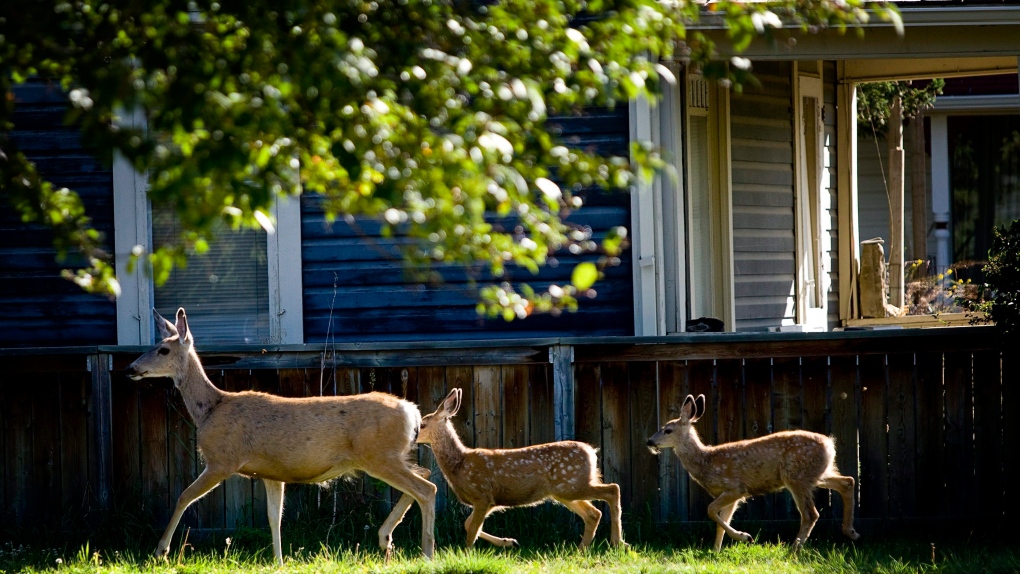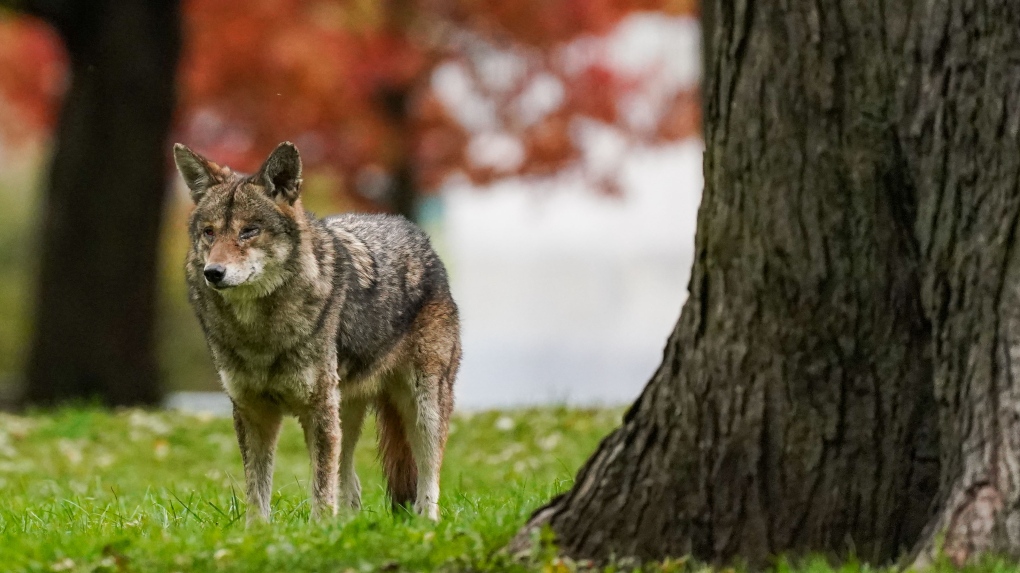Coyotes, raccoons, deer and beavers are a growing problem in Canadian cities. Wildlife experts suggest humans are partly to blame
Raccoons giving birth in a balcony and bathtub. Hundreds of bats living in attics. Squirrels chewing TV cables. Deer attacking dogs and strollers.
Wildlife professionals say a growing number of animals are making their homes in cities and towns across Canada, which is causing problems for humans.
“We know from the news, social media, our own observations that interactions with wildlife are increasing throughout Canada and this trend is occurring around the world,” Colleen Cassady St. Clair, a professor of biological sciences at the University of Alberta in Edmonton, said in a video interview with CTVNews.ca.
Although St. Clair isn’t aware of any good statistics about the number of human-wildlife interactions for most species, she said data exists for some. Her project on coyotes in Edmonton found that the number of “bold” encounters people are having with the animals has increased over the last 10 years, a trend that is similar in other cities.
 A mother deer and her fawns move down a sidewalk in a residential neighbourhood in Okotoks, Alta., on Aug. 23, 2011. (Jeff McIntosh / The Canadian Press)
A mother deer and her fawns move down a sidewalk in a residential neighbourhood in Okotoks, Alta., on Aug. 23, 2011. (Jeff McIntosh / The Canadian Press)
Behind rise in wildlife ‘interactions’
As the size of cities, and human and wildlife populations, grows, so do the number of human-wildlife interactions, St. Clair said.
“Sometimes this is because cities are extending into areas that used to be occupied by the wildlife,” she said. “But more often it’s because wildlife themselves are capable of adapting to live close to humans. Prey species are particularly effective at doing this.”
Urban deer have become problems in many areas across Canada, she said, as they and other prey animals move to cities to escape predators.
“The main attractant for wildlife to cities is the food that humans provide intentionally or unintentionally,” she said. “But we also provide shelter in our cities. Cities are warmer.”
Food, such as garbage, compost, pet food, bird seed, ornamental fruit and fallen fruit, are attracting wildlife to cities and the problem has gotten worse, she said.
Bill Dowd, CEO and founder of Skedaddle Humane Wildlife Control, which has been operating since 1989 with franchises across Canada and the United States, says business has been booming. Skedaddle has fielded a record number of calls in February and March, from Halifax to Victoria, B.C., about wildlife in residences and businesses, he said.
Cities are now a “natural habitat” for raccoons, squirrels, skunks, birds, bats, mice and rats, Dowd said in a video interview with CTVNews.ca.
“Any mature city that has mature trees and a water source … is going to have a problem not only with wildlife but also insects as well,” he said.
Humans may be partly to blame for inadvertently creating many habitats in urban areas that are attractive to animals, suggested Bill Abercrombie, a professional trapper, hunter and guide.
Abercrombie said the phenomenon of wildlife-human conflicts has been taking place for a few decades.
“There are more wild animals moving into urban habitats than there ever has been before,” he said in a video interview with CTVNews.ca. “Not just Canada-wide but North America-wide.”
Abercrombie’s company, Animal Damage Control, based in Fort Saskatchewan, Alta., provides wildlife management, research and consulting services to all levels of government, industry and institutions across Canada.
He said the wildlife population has exploded in areas surrounding urban centres, as well, noting many of these spots may be agricultural land or urbanized rural areas.
Over time, these animals become more comfortable and lose their fear of humans, he pointed out.
 A sedated grizzly sow is shown before she and her two cubs were relocated to an area around Nelson, B.C., on Oct. 1, 2023. (Lisa Thomson / Handout via The Canadian Press)
A sedated grizzly sow is shown before she and her two cubs were relocated to an area around Nelson, B.C., on Oct. 1, 2023. (Lisa Thomson / Handout via The Canadian Press)
Problem animals
These conditions can result in the overpopulation of species such as mule deer and white-tailed deer, rabbits, coyotes, foxes and bobcats, Abercrombie said.
“There is quite often conflict and collateral damage on both sides when you have large populations of predators in close proximity to people, right in residential areas,” he said.
The animals will have the same behaviour they have in the wild, posing risks to humans, children and pets. “Quite often there’s conflict and sometimes it’s fairly serious,” Abercrombie said. “The natural checks and balances that would be in place in a natural habitat … are not in place in an urbanized habitat.”
Abercrombie, who provides advice to cities like Moncton, N.B., and Calgary, says they currently have a problem with coyotes that are used to humans and are being found in many residential communities. Their population is also “very high” in Edmonton and surrounding areas, he added.
“So coyotes live there, breed there, raise their young there, but they’re predators,” Abercrombie said. “And so they compete territorially with each other, which leads to often increased, heightened aggressive state of behaviour with the coyotes, because there’s a lot of competition.”
Along with preying on their natural diet of rodents, coyotes are “opportunistic” and can target domestic pets, Abercrombie added.
Predatory attacks on pets can sometimes lead to humans getting hurt, as well, he said.
Meanwhile, beavers have become prevalent in urban areas in Eastern Canada and the Prairie provinces, Abercrombie said, with favourable conditions like warmer weather and thin ice conditions increasing their urban presence.
“It’s the same sort of scenario where we’ve created super habitats surrounding major urban centres,” Abercrombie said. “And the beavers find themselves pressed for territory and food so they happily move into urban areas.”
The presence of more beavers in urban areas depletes trees, making it hazardous for humans nearby.
“If there’s no check on the population, they cut a lot of trees and it can be a real problem in cities, (with) falling trees all over the place,” Abercrombie said.
Beavers can also wreak havoc on urban infrastructure if they dam up areas, such as storm sewers, that are meant to allow water to flow freely, he added.
Abercrombie said he observed more wildlife out and about during the recent mild winter in Alberta.
And while normally a problem in Eastern Canada, more raccoons have also shown up in the greater Edmonton area over the past five years, he added.
Jesse Zeman, executive director of the B.C. Wildlife Federation, said his organization has observed an increase in conflicts between humans and bears in the province. The trend is tied to the dry summer, wildfires, and fewer berries and salmon, he said.
Urban deer, namely white-tailed deer, black-tailed deer and mule deer, are a major problem in B.C., as well. Their migration to cities over the last decade has resulted in a spike in vehicle collisions, resulting in millions of dollars a year in damages. Deer have also attacked strollers with kids and even killed dogs, he said.
“Urban deer that are now living in cities and towns across British Columbia are creating a major conservation concern in terms of disease, transferring and acting as a vector for chronic wasting disease,” Zeman said. He said the neurological disease is similar to mad cow disease and is fatal and incurable.
 A coyote is spotted at a park in Toronto on Nov. 3, 2021. (Evan Buhler / The Canadian Press)
A coyote is spotted at a park in Toronto on Nov. 3, 2021. (Evan Buhler / The Canadian Press)
Taking ‘responsibility’ for problem
A solution to the problem is ensuring humans don’t provide wildlife access to food, St. Clair said. “That means securing garbage, compost, pet food, bird seed, fruit from ornamental trees.”
It’s also helpful for people to realize that animal populations should be controlled, especially species that can cause conflict with humans, St. Clair said.
“The controlling effect of small predators like coyotes on populations of rodents, for example, is a benefit to people,” she said. “For some wildlife species in cities that are very good at exploiting people, it’s necessary to control their populations, preventing them from becoming hyperabundant.”
Abercrombie agrees. “Coexistence is only possible if we actually take responsibility and manage the species that really need management,” he said. “The reality is life and death is part of nature. And that’s the reality for wild animals in a natural setting without so many people.”
It doesn’t benefit animals if they are overpopulated, he argues. “Because that means there’ll be a heightened stress, heightened competition, overpopulation and a lack of resources,” he said. “And when that happens, animals’ behaviour becomes unpredictable and at that point they can be a threat.”
Beyond potentially becoming a physical threat, animals under stress can get parasites, viruses, infections and disease, he said.
Dowd said he believes it’s too late to do anything about wildlife living in cities and most don’t survive if they are relocated to more rural areas.
But he suggests people “animal proof” their homes, such as by putting screens on chimneys, roof vents, wall vents, plumbing vents or other “vulnerable” areas.
“We’re long past the time where we can get animals out of our cities … they’re here to stay and they’re flourishing,” he said. “The populations are so high nowadays, we’re never going to get rid of all these urban animals. So homeowners must be diligent and protect their home.”
View original article here Source









